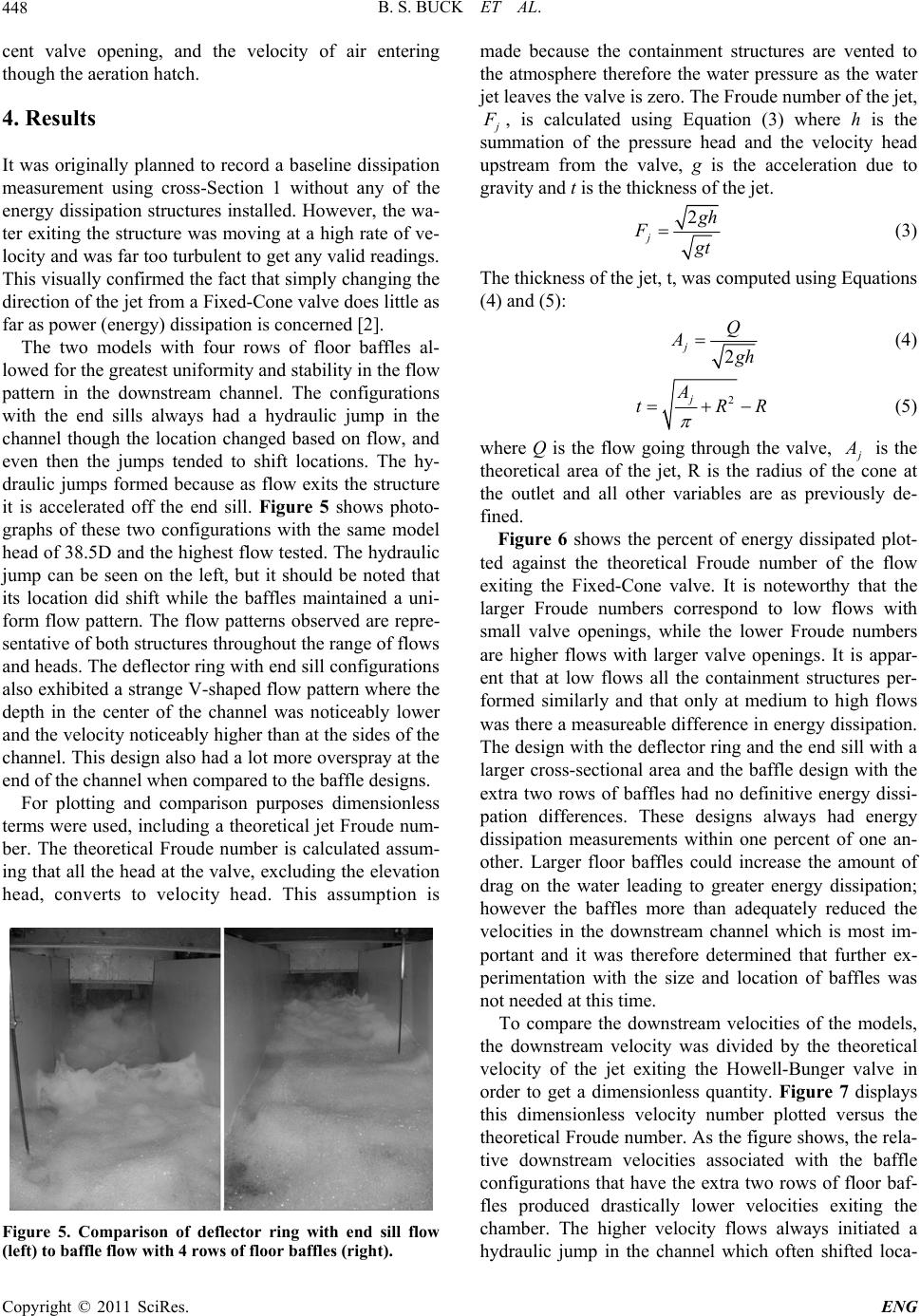
B. S. BUCK ET AL.
448
cent valve opening, and the velocity of air entering
though the aeration hatch.
4. Results
It was originally planned to record a baseline dissipation
measurement using cross-Section 1 without any of the
energy dissipation structures installed. However, the wa-
ter exiting the structure was moving at a high rate of ve-
locity and was far too turbulent to get any valid readings.
This visually confirmed the fact that simply changing the
direction of the jet from a Fixed-Cone valve does little as
far as power (energy) dissipation is concerned [2].
The two models with four rows of floor baffles al-
lowed for the greatest uniformity and stability in the flow
pattern in the downstream channel. The configurations
with the end sills always had a hydraulic jump in the
channel though the location changed based on flow, and
even then the jumps tended to shift locations. The hy-
draulic jumps formed because as flow exits the structure
it is accelerated off the end sill. Figure 5 shows photo-
graphs of these two configurations with the same model
head of 38.5D and the highest flow tested. The hydraulic
jump can be seen on the left, but it should be noted that
its location did shift while the baffles maintained a uni-
form flow pattern. The flow patterns observed are repre-
sentative of both structures throughout the range of flows
and heads. The deflector ring with end sill configurations
also exhibited a strange V-shaped flow pattern where the
depth in the center of the channel was noticeably lower
and the velocity noticeably higher than at the sides of the
channel. This design also had a lot more overspray at the
end of the channel when compared to the baffle designs.
For plotting and comparison purposes dimensionless
terms were used, including a theoretical jet Froude num-
ber. The theoretical Froude number is calculated assum-
ing that all the head at the valve, excluding the elevation
head, converts to velocity head. This assumption is
Figure 5. Comparison of deflector ring with end sill flow
(left) to baffle flow with 4 rows of floor baffles (right).
made because the containment structures are vented to
the atmosphere therefore the water pressure as the water
jet leaves the valve is zero. The Froude number of the jet,
, is calculated using Equation (3) where h is the
summation of the pressure head and the velocity head
upstream from the valve, g is the acceleration due to
gravity and t is the thickness of the jet.
2
j
h
F
t
(3)
The thickness of the jet, t, was computed using Equations
(4) and (5):
2
jQ
A
h
(4)
2
j
A
tR
R
(5)
where Q is the flow going through the valve,
is the
theoretical area of the jet, R is the radius of the cone at
the outlet and all other variables are as previously de-
fined.
Figure 6 shows the percent of energy dissipated plot-
ted against the theoretical Froude number of the flow
exiting the Fixed-Cone valve. It is noteworthy that the
larger Froude numbers correspond to low flows with
small valve openings, while the lower Froude numbers
are higher flows with larger valve openings. It is appar-
ent that at low flows all the containment structures per-
formed similarly and that only at medium to high flows
was there a measureable difference in energy dissipation.
The design with the deflector ring and the end sill with a
larger cross-sectional area and the baffle design with the
extra two rows of baffles had no definitive energy dissi-
pation differences. These designs always had energy
dissipation measurements within one percent of one an-
other. Larger floor baffles could increase the amount of
drag on the water leading to greater energy dissipation;
however the baffles more than adequately reduced the
velocities in the downstream channel which is most im-
portant and it was therefore determined that further ex-
perimentation with the size and location of baffles was
not needed at this time.
To compare the downstream velocities of the models,
the downstream velocity was divided by the theoretical
velocity of the jet exiting the Howell-Bunger valve in
order to get a dimensionless quantity. Figure 7 displays
this dimensionless velocity number plotted versus the
theoretical Froude number. As the figure shows, the rela-
tive downstream velocities associated with the baffle
configurations that have the extra two rows of floor baf-
fles produced drastically lower velocities exiting the
chamber. The higher velocity flows always initiated a
hydraulic jump in the channel which often shifted loca-
Copyright © 2011 SciRes. ENG